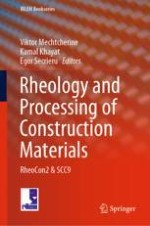2020 | OriginalPaper | Buchkapitel
Hydrating Cement Particle Interaction Model for Yield Stress Analysis
verfasst von : Neven Ukrainczyk, Antonio Caggiano, Diego Said Schicchi, Albrecht Gilka-Bötzow, Eddie Koenders
Erschienen in: Rheology and Processing of Construction Materials
Aktivieren Sie unsere intelligente Suche, um passende Fachinhalte oder Patente zu finden.
Wählen Sie Textabschnitte aus um mit Künstlicher Intelligenz passenden Patente zu finden. powered by
Markieren Sie Textabschnitte, um KI-gestützt weitere passende Inhalte zu finden. powered by
